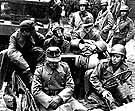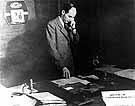
|
|
|

|

|

|

|
|
Click on an image to see a larger, more detailed picture.
|
|
|
|
|
| 1944: Desperate Acts |

|
pg. 570 |

|
|
|
|
| |
 Head bowed in defeat, the commander of the German garrison in Aachen, Germany, Colonel Gerhard Wilck, accompanied by three of his officers, sits in a U.S. Army jeep after his capture. Although months of fighting, including the Battle of the Bulge, lay ahead, the German defeat now appeared to be only a matter of time as the Western Allies pushed toward the Rhine and the Soviets moved into East Prussia. With the capture of Aachen on October 21, American troops stood for the first time on German soil.
Head bowed in defeat, the commander of the German garrison in Aachen, Germany, Colonel Gerhard Wilck, accompanied by three of his officers, sits in a U.S. Army jeep after his capture. Although months of fighting, including the Battle of the Bulge, lay ahead, the German defeat now appeared to be only a matter of time as the Western Allies pushed toward the Rhine and the Soviets moved into East Prussia. With the capture of Aachen on October 21, American troops stood for the first time on German soil.
Photo: Suddeutscher Verlag Bilderdienst
|
 Chaim Weizmann makes an address in Tel Aviv, Palestine, to an audience of Jewish Brigade volunteers. Weizmann was the leader of the World Zionist Organization, the goal of which was to encourage Jews to emigrate to Palestine and establish a Jewish state there. Having fled antisemitism in both Russia and Germany, where he had been a chemistry professor, Weizmann became the first president of the state of Israel, in February 1949.
Chaim Weizmann makes an address in Tel Aviv, Palestine, to an audience of Jewish Brigade volunteers. Weizmann was the leader of the World Zionist Organization, the goal of which was to encourage Jews to emigrate to Palestine and establish a Jewish state there. Having fled antisemitism in both Russia and Germany, where he had been a chemistry professor, Weizmann became the first president of the state of Israel, in February 1949.
Photo: Central Zionist Archives/United States Holocaust Memorial Museum Photo Archive
|
 Raoul Wallenberg
Raoul Wallenberg
The determined, energetic efforts of young Swedish diplomat Raoul Wallenberg saved thousands of Hungarian Jews from certain death in the gas chambers of Auschwitz. Sent to Budapest by the Swedish Foreign Ministry, Wallenberg worked to save the city's remaining 200,000 Jews from planned deportations in July 1944. He issued thousands of special Swedish Embassy-stamped "protective passports" to Hungarian Jews. Armed with funds supplied by the War Refugee Board, Wallenberg also bought property in Budapest, which he turned into "safe houses" for those rescued from transports. In organizing a network of hundreds of young Jewish agents, he managed the distribution of food and medicine to Jews taking refuge in those shelters. Using bluff and diplomatic credentials, Wallenberg even pressured the SS into turning over to him some prisoners already on board deportation trains. As Adolf Eichmann initiated the death marches of thousands of Jews toward the Austrian border, Wallenberg pursued the departing columns, winning the release of many of those in possession of the Swedish passports. In early 1945, as the Soviet Army neared Budapest, he dissuaded the SS commander from carrying out an ordered massacre of Jews still in the city. After Budapest's liberation, Wallenberg disappeared, presumably arrested by the Soviets on espionage charges. His fate remains a mystery.
Photo: Thomas Veres / United States Holocaust Memorial Museum Photo Archive
|
|

|

|

|

|
 November 1944: The final 400 slave laborers in Piotrków, Poland, are force-marched to Bergen-Belsen, Germany; Buchenwald, Germany; Mauthausen, Austria; and other concentration camps.
November 1944: The final 400 slave laborers in Piotrków, Poland, are force-marched to Bergen-Belsen, Germany; Buchenwald, Germany; Mauthausen, Austria; and other concentration camps.
|
 November 1944: Jewish parachutists recruited by the British in Palestine are dropped behind German lines.
November 1944: Jewish parachutists recruited by the British in Palestine are dropped behind German lines.
|
 November 1944: A non-Jewish Polish physician, Stanislaw Switala, shelters seven former leaders of the Jewish Fighting Organization, including Yitzhak Zuckerman and Tuvia Borzykowski, in his hospital.
November 1944: A non-Jewish Polish physician, Stanislaw Switala, shelters seven former leaders of the Jewish Fighting Organization, including Yitzhak Zuckerman and Tuvia Borzykowski, in his hospital.
|
 November 1944: The Hungarian government agrees to establish an international Jewish ghetto in Budapest, where Jews in 72 buildings will be protected under Swiss authority; See December 31, 1944.
November 1944: The Hungarian government agrees to establish an international Jewish ghetto in Budapest, where Jews in 72 buildings will be protected under Swiss authority; See December 31, 1944.
|
|
|
|
|
| 1944: Desperate Acts |

|
pg. 570 |

|
|
The Holocaust Chronicle
© 2009 Publications International, Ltd.
|
|
